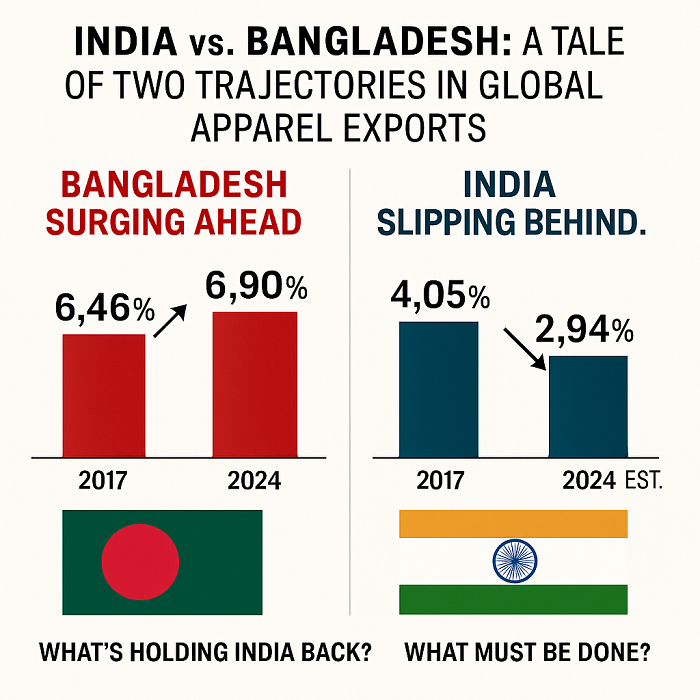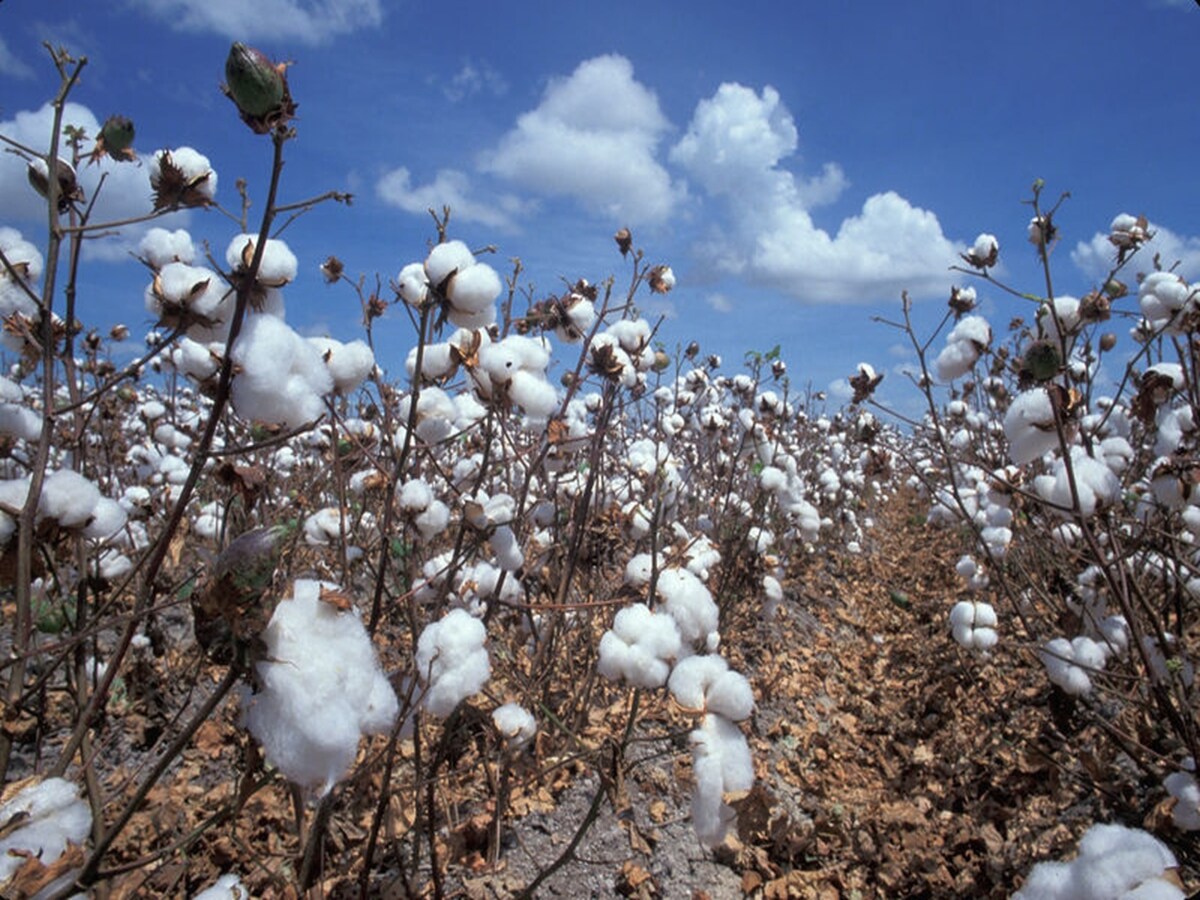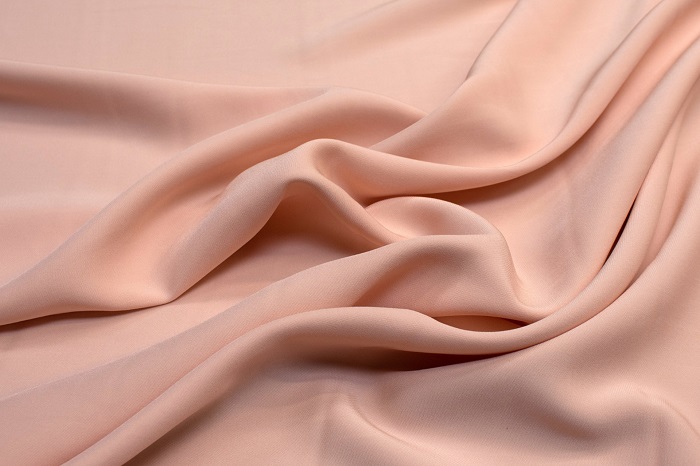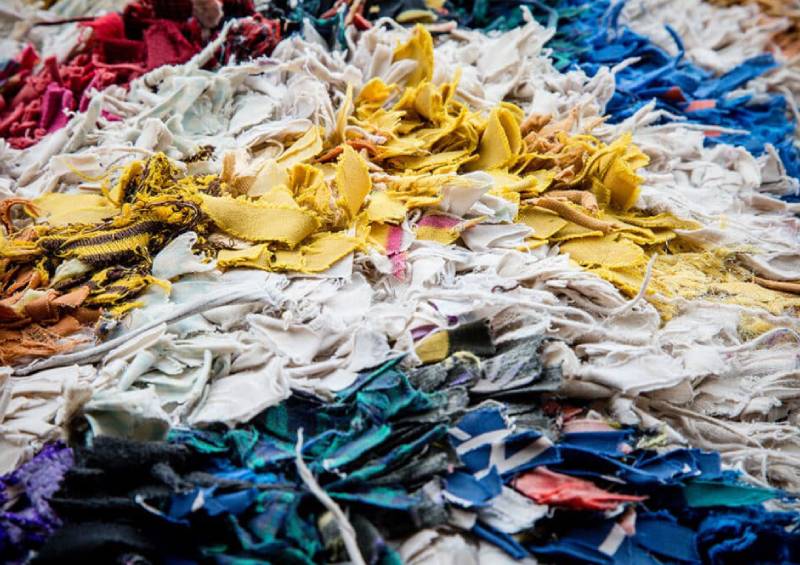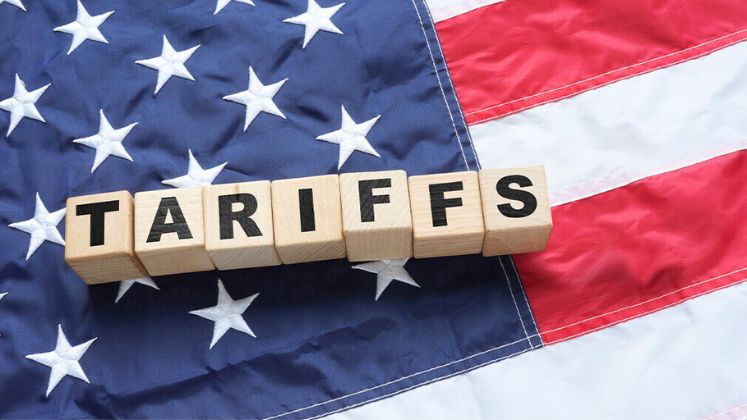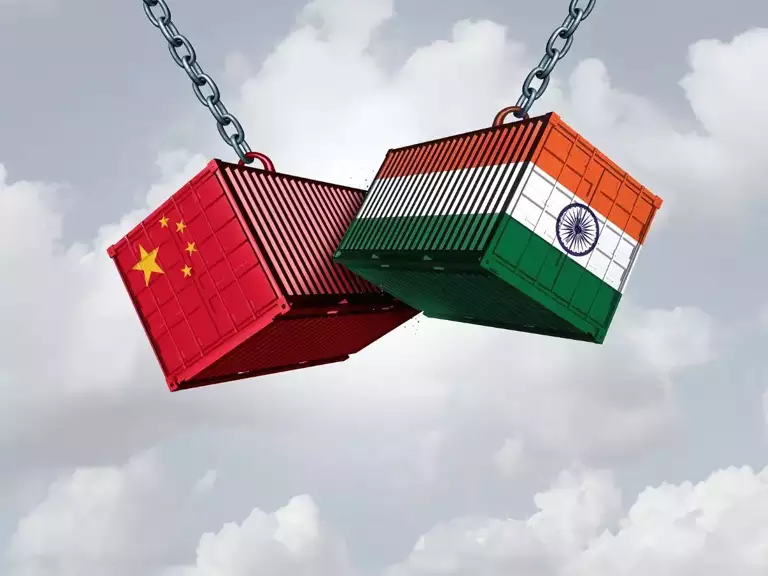Pakistani entrepreneurs investing in Bangladesh's textile sector have expressed increased concerns about the recent turmoil and unrest in the country, fearing instability similar to that in Pakistan. The prospect of martial law in Bangladesh heightens these concerns, potentially jeopardising the stability that attracted these investors in the first place.
In recent years, several Pakistani textile entrepreneurs relocated their operations to Bangladesh. The move was motivated by lower production costs, preferential trade agreements, and superior infrastructure. The world's second-largest apparel exporter after China, Bangladesh has been steadily gaining market share as Western sanctions have hit Chinese exports. Many Pakistani firms, particularly in home textiles and readymade garments, have capitalised on Bangladesh's strategic advantages, reducing production costs by nearly 50 per cent.
Among the notable companies that set up operations in Bangladesh includeSoorty Enterprises, which invested $35 million in a garment factory employing around 6,000 Bangladeshis, and Interloop. Other significant names include Pak Denim, Crescent Textile Mills, Gul Ahmed Textile Mills, Kohinoor Textile Mills, Al-Karam Textile Mills, Nishat Mills (part of the Nishat Group), Artistic Milliners, and Masood Textile Mills.
These companies benefited from Bangladesh's lower labor costs and favorable trade agreements with the European Union and the United States, which offer better market access and lower tariffs compared to Pakistan. Despite Pakistan being granted GSP+ status by the EU in 2013, Bangladesh's economic incentives made it a more attractive destination for Pakistani firms seeking to maximise profits.
However, Muhammad Jawed Balwani, Chairman, Pakistan Apparel Forum, notes, while prominent companies like Soorty and Interloopcontinue to operate successfully in Bangladesh, the political climate under former Prime Minister Sheikh Hasina was not always welcoming, as her policies were seen as pro-India. The new military government would be more favorable toward Pakistani investors, he hopes.
Rising production costs and stagnant textile exports are making survival difficult for the power loom industry in Karachi, Pakistan. The past two and half years have been particularly challenging for the sector as economic activities in the country slowed down. The introduction of heavy taxation measures in the budget for the current financial year has further worsened the situation. Threatening to further weaken the sector, these measures could potentially lead to the closure of small and medium-sized businesses, warn experts.
Expressing his disappointment over the government’s lack of commitment to economic and industrial development TabbasumHussain, Secretary General, Power Looms Association in Karachi, says, the power loom industry plays a critical role in generating revenue and creating employment opportunities. Shutting down these looms would not only deprive the government of a valuable revenue stream but also result in massive job losses, he warns.
Hussain urges Prime Minister Shehbaz Sharif, Finance Minister Muhammad Aurangzeb, and Commerce Minister Jam Kamal to reconsider the taxes, electricity, and gas rates. It is essential to reduce these costs is essential to keep the sector operational. The government should also revise the taxation policy to ensure smooth functioning of these power looms to prevent further economic decline, he emphasises.
After re-launching the brand, ’Pony’ in the footwear category in 2023, the Iconix Brand Group plans to re-introduce the brand in the apparel segment with a target of reaching $500 million in sales in the near future.
Founded over 50 years ago in New York City by Roberto Muller, with support from Horst Dassler, Chairman, Adidas, Pony soon became a popular footwear brand among athletes across various sports. At its peak, Pony's sales reached around $800 million. Iconix acquired the North American rights for the brand in 2015 for $37 million and expanded to the rest of the world, excluding mainland China, in 2022.
Iconix recently signed Reason Clothing, a company known for its strong connections with specialty stores, as a licensee for the relaunch with a major apparel push planned for next year.
To complement Pony’s footwear, Robert Galvin, CEO, Iconix Brand Group, aims to introduce ‘hip apparel’range. Currently, the brand’s offerings comprise 70 per cent menswear and 30 per cent womenswear. However, it plans to expand its womenswear range with plans to venture in India also.
Pony will continue to leverage high-profile collaborations, such as partnerships with Star Wars, Mexican comedian Ricardo Perez, fashion designer Mauro Garfias, and events like the hip-hop festival Summer Jam and New York City's Hot 97. The brand has also been involved in community projects, such as reopening a skatepark in Luque, Paraguay.
Pony’s apparel is available at major retailers like Selfridges, Liberty, and Urban Outfitters abroad. In the US, the brand aims to expand through sports specialty stores and larger retailers like Macy’s. Iconix is also exploring six to eight potential acquisitions to further expand its portfolio, with its most recent purchase being the British streetwear label Hoodrich.

The fashion industry, like many others, grappled with significant price fluctuations due to COVID-19. Many key factors have impacted these shifts. From rising raw material costs to inflationary pressures and change in consumer demand the reasons are many.
Factors driving prices fluctuations
Several factors are responsible for price fluctuations. One major factor is supply chain snags. Pre-pandemic, globalization led to a steady decline in apparel prices. However, COVID-induced disruptions like factory shutdowns and port congestion caused a sharp rise in production and transportation costs. These increased production costs translated to higher prices for consumers. Meanwhile, the cost of cotton, a key raw material, has seen fluctuations due to various factors, impacting garment pricing.
With lockdowns and a focus on comfort wear and work-from-home culture, demand for formal attire dipped, and that of loungewear and activewear went up. This shift in preferences impacted brands and they adjusted production accordingly, impacting prices in different categories. Inflationary pressure is another issue. Rising costs of everything from cotton to labor contributed to overall price increases across the industry.
Impact of price change
Frequent price changes affected retail sales across the board. Luxury brands initially saw a dip in sales as travel and events were curtailed. However, some saw an increase due to ‘trading down’ by high-income consumers unwilling to stomach massive price hikes. And some luxury labels even responded by lowering prices.
This premium segment saw price increases to maintain an image of quality while managing rising manufacturing costs. Strong product assortments with unique offerings held the key to customer loyalty and price acceptance. For example, Abercrombie & Fitch's recent success exemplifies this strategy. Many brands focused on offering unique propositions to justify price increases. The value segment faced the biggest challenge. Value-conscious consumers were most reactive to price hikes, opting for cheaper alternatives or delaying purchases. Retailers like Gap needed to rely heavily on appealing product lines to justify price adjustments.
To deal with price fluctuations, brands and retailers are adopting various strategies. Many retailers are adopting a two-tiered approach – offering discounts on generic items while charging a premium for anything unique or with special features (e.g., sustainable materials, innovative design). Levi's exemplifies this by slashing prices on slow-moving styles while marking up trendier fits.
They are also creating exciting new trends in apparel encourages consumers to refresh their wardrobes, even at slightly higher price points. Abercrombie & Fitch's success with on-trend dresses is a prime example. And brands are emphasizing unique attributes like sustainable materials, circularity, or innovative features to justify price increases and build customer loyalty.
What lies ahead?
Volatility: Analysts predict continued volatility. While some relief came from lower logistical costs, rising fuel prices and geopolitical tensions may push costs up again.
Brands may resist cuts: Even with stagnant sales, some brands may be hesitant to lower prices. They might view the spending slowdown as a shift towards experiences (dining out, travel) rather than a reflection on clothing costs.
Consumer pain threshold: With rising debt and delinquencies across all age groups, consumers' patience for price hikes might be wearing thin. The recent decline in apparel price increases, despite overall inflation, suggests this might be happening already.
The apparel industry has gone through a roller-coster price changes due to the pandemic. While the future remains uncertain, one thing is clear: brands and retailers that adapt their pricing strategies, focus on product innovation, and build strong value propositions will be best positioned to thrive in this ever-changing landscape. As retail analysts explain, one needs to see what consumers are willing to spend on, and push it a little bit if business is good. But pushing too hard, as inflation continues to bite, might backfire. The question remains: when will shoppers finally push back on high prices?

The report ‘2024 USFIA Fashion Industry Benchmarking Study’ released in collaboration with University of Delaware highlights the change in apparel sourcing patterns. The study highlights the mounting economic pressures faced by the US fashion industry, including inflation, supply chain disruptions, and geopolitical tensions. These challenges have accelerated a trend towards diversification, creating a golden opportunity for India. For the first time ever, India has surpassed Bangladesh as the top apparel sourcing destination for US fashion companies.
Reducing China sourcing
A significant shift in apparel sourcing dynamics is evident from the latest survey findings. This year, a record 43 per cent of respondents scaled back their apparel sourcing from China to less than 10 per cent, a notable increase from just 18 per cent in 2018. Moreover, nearly 60 per cent of those surveyed no longer consider China their primary apparel supplier in 2024, marking a substantial rise compared to the pre-pandemic range of 25-30 per cent.
Despite China's recognized economic competitiveness in apparel manufacturing—such as robust vertical integration, low minimum order quantities (MOQs), flexibility, cost-effectiveness, and rapid market responsiveness—non-economic factors are driving a strategic reshaping of supply chains. Heightened concerns over forced labor risks and geopolitical uncertainties are compelling US fashion companies to diversify their sourcing away from China. This strategic realignment extends to companies actively selling products within China.
Looking ahead, nearly 80 per cent plan to further decrease their reliance on Chinese sourcing over the next two years, signalling a sustained trend towards risk mitigation. Large-scale US fashion enterprises, particularly those with over 1,000 employees and substantial current Chinese sourcing, are at the forefront of efforts to "de-risk" their supply chains.
India, capitalizing on global challenges
In 2024, a notable shift in sourcing patterns emerged as more respondents indicated sourcing from India (89 per cent utilization rate) than from Bangladesh (86 per cent utilization rate) for the first time in survey history. This trend highlights India's rising prominence as a preferred apparel sourcing destination among surveyed companies.
Looking forward, nearly 60 per cent respondents expressed intentions to increase their apparel sourcing from India over the next two years. This planned expansion surpasses growth projections for any other Asian country, underscoring India's growing appeal as a strategic sourcing hub in the region. India's vast skilled workforce, coupled with a growing domestic market, has been instrumental in its success. The country's rich textile heritage and diverse production capabilities offer global brands a wide range of options, from high-end fashion to mass-market apparel. Furthermore, the government's initiatives to promote 'Make in India' have created a positive ecosystem for apparel manufacturers.
India has capitalized on these challenges, positioning itself as a preferred alternative to traditional sourcing hubs. For the first time, India has surpassed Bangladesh as the most sought-after apparel sourcing destination for US fashion companies. This growth is due to a combination of factors:
Cost competitiveness: India offers a compelling cost advantage compared to many other sourcing destinations.
Skilled workforce: The country has a large pool of skilled labor, capable of meeting the demands of the fashion industry.
Government support: The Indian government's focus on boosting the textile and apparel sector through initiatives like the Production Linked Incentive (PLI) scheme has created a conducive environment for businesses.
Sustainability focus: Emphasizing sustainable practices, such as eco-friendly production processes and ethical sourcing, can attract environmentally conscious global brands.
Infrastructure development: Continued investment in transportation, logistics, and port infrastructure is essential to ensure efficient and cost-effective supply chains.
While economic factors have undoubtedly played a role, India's growing appeal also stems from its ability to address other critical concerns for US brands. The country has made significant strides in improving labor standards and sustainability practices, aligning with the increasing emphasis on ethical sourcing.
Despite the promising outlook, India faces certain challenges that need to be addressed. On major one is infrastructure bottlenecks. While significant progress has been made, infrastructure development still lags behind in some regions, impacting supply chain efficiency. Rising labor costs could also erode India's competitive advantage, necessitating a focus on productivity and value-added services. And another important aspect is addressing trade barriers and improving market access in key export destinations will be crucial for sustained growth.
By effectively addressing these challenges and capitalizing on the opportunities presented, India can solidify its position as a global fashion sourcing powerhouse and contribute significantly to the country's economic growth.
Martin Shankland, Executive Board member for Global Operations, will step down from Adidas on August 10, 2024, ending his 27year tenure with the company. The Supervisory Board approved the mutual decision for Shankland's departure.
Thomas Rabe, Chairman of the Supervisory Board, expressed gratitude for Shankland's significant contributions, praising his passion, commitment, and leadership. Shankland's career at Adidas began in 1997 with Adidas Russia/CIS, where he established a market-leading direct-to-consumer business. He later led the Emerging Markets region and joined the Executive Board in 2019, overseeing product operations, sourcing, supply chain, tech, data, and sustainability.
Shankland spearheaded key transformations, enhancing supply chain transparency and sustainability, and advancing Adidas's tech capabilities by insourcing tech talent.
Post-departure, Hoa Ly, SVP Sourcing, will oversee sourcing operations, reporting to CEO Bjorn Gulden. CFO Harm Ohlmeyer will take on additional responsibilities for supply chain and tech. The new Executive Board, effective August 11, 2024, will include Bjorn Gulden, Arthur Hoeld, Harm Ohlmeyer, and Michelle Robertson.
Starting January 1, 2025, the AATCC (American Association of Textile Chemists & Colorists) Journal of Research (AJOR) will become an Open Access Journal, making vital information in textile chemistry, coloration, testing, and advanced materials freely accessible to researchers and professionals worldwide.
Previously, access to AJOR was limited to AATCC members or through paid subscriptions. The shift to Open Access eliminates these barriers, allowing anyone to view all past and present articles at no cost.
This change aligns with AATCC’s mission to disseminate knowledge and enhance education within the textile industry. AJOR has a long-standing reputation for publishing high-quality, peer-reviewed research, serving as a crucial resource for AATCC members to stay updated on advancements in textile science.
The decision to open AJOR to the public is a significant step towards broadening the reach of textile research and fostering collaboration among global professionals.
Key figures in this initiative include Editor in Chief Gang Sun (University of California, Davis), Deputy Editor Chi WaiKan (Hong Kong Polytechnic University), and Publications Chair Jiping Wang (Shanghai University of Engineering Science), who have played a vital role in this transition.
Fashion for Good, along with partners adidas, Inditex, ON Running, PVH Corp., Reformation, Target, and Zalando, has announced a new initiative to advance footwear sustainability. This effort builds on their expertise in innovation and collaboration, targeting key areas to drive footwear circularity.
Annually, 23.9 billion shoes are produced worldwide, often composed of over 40 different materials like TPU, EVA, PU, and rubber. The complexity of shoe construction and low collection rates result in most discarded footwear ending up in landfills. Fashion for Good aims to tackle this by focusing on circularity and accelerating innovation in footwear recycling.
Four core workstreams
Materials: Scouting and validating sustainable alternatives for footwear materials.
Design: Defining circular design and driving guidelines for circular infrastructure.
End of Use: Developing data on post-consumer footwear waste and validating solutions for repair, disassembly, and recycling.
Traceability: Creating a traceability data protocol to substantiate sustainability claims.
Fashion for Good’s experience in multi-stakeholder projects and innovation validation will be pivotal. Partners, including The Footwear Collective, will align efforts to achieve significant results.
Katrin Ley, Managing Director of Fashion for Good, emphasized the organization's and its partners' recognition of the urgent need to accelerate innovation in footwear sustainability. She highlighted their goal to drive circularity and validate sustainable solutions in a segment that is ready for disruption.
Sigrid Buehrle, SVP of Product Operations at adidas, noted that their partnership with Fashion for Good has led to several sustainable innovation initiatives. She expressed their intention to now focus on footwear and address challenges related to the scalability of low-impact materials.
India is poised to become a favorable option for clothing brands looking to diversify their sourcing away from countries where they currently have significant exposure, opines SivaramakrishnanGanapathi, Managing Director, Gokuldas Exports.
The recent events in Bangladesh might accelerate the diversification plans of many clothing brands, Ganapati points out. India's extensive supply chain will attract retailers to consider incremental sourcing from the country, he adds.
Gokuldas Exports collaborates with numerous global garment retailers, including those operating in Bangladesh. However, the country recently experienced significant unrest due to protests against a government policy reserving 30 per cent of civil service jobs for freedom fighters and their descendants. This political turmoil led to the resignation and subsequent escape of Prime Minister Sheikh Hasina,
Ganapathi believes, this instability could compel retailers to reconsider their sourcing strategies, with India emerging as a potential alternative. However, it may still be too early to see a substantial shift in sourcing or changes in orders from Bangladesh, he warns.
In terms of cost, Bangladesh currently has several advantages over India, such as lower labor costs, a weaker currency, and duty-free access to European markets. As India's free-trade agreements with the UK and Europe progress, the competitive landscape could change, potentially leveling the playing field, Ganapathi notes.
A women’s intimatewear brand, Commando plans to expand into the men’s underwear category with its first full collection to be launched this fall.
Starting with two microfiber styles, Commando soon expanded into a wide range of women’s intimates along with bodysuits, leggings, pants, shirts, shorts, skirts, dresses and even jeans.
The brand’s new men’s collection will comprise three categories: Essential, the male version of Commando’s best-selling Butter line for women, and described as a ‘super soft and tactile.’ range. These micro modal pieces will be offered in relaxed or modern-fit trunks, boxer-briefs or briefs in black, navy or titanium in sizes small to XXL. They will retail for $46 or $48.
Next would be the Classic collection that would be created from the comfortable and quick drying Italian microfiber fabrics. In addition to the briefs, trunks and boxers, the collection will alsooffer crewneck and V-neck undershirts in white, black, navy and slate. These will retail for $48 to $54 for the underwear and $88 for the undershirts.
The third category, ‘Ultimate,’ is the ‘lowest profile’ product in bonded microfiber fabrics with bonded edges. It is being offered in boxer-briefs, trunks and briefs in black and will retail for $46 to $50.
In addition to being sold on the Commando e-commerce site, the men’s line is also being sold at Saks Fifth Avenue, Bloomingdale’s, Neiman Marcus, Bergdof Goodman, Revolve and other specialty stores.
According to Kerry O’Brien, Founder, the men’s assortment will follow the same trajectory as the women’s, with more categories and products being added as it becomes established.
More...
- 1
- 2
- 3
- 4
- 5
- 6
- 7
- 8
- 9
- 10
Digital Thread to Physical Touch: The tug of war between touchscreens and tactil…
In a world where fashion unfolds in pixels and checkout happens with a click, legacy fashion brands are wrestling with... Read more
India vs. Bangladesh in the global apparel export market
The global apparel market is a dynamic arena, and a close examination of the data reveals a compelling story of... Read more
The BIS Dilemma: Is India’s cotton policy unravelling its export dream?
The Indian textile sector—one of the most important pillars of our economy—is now confronting an important moment. The Ministry of... Read more
Roica showcases high-performance textile innovations at Milano Unica
A premium stretch fiber developed by Asahi Kasei, Roica is at the forefront of the textile industry's shift towards more... Read more
Transatlantic Tensions: How US tariffs are threatening the future of Europe’s te…
The European textile and apparel industry, a major contribute to the continent’s manufacturing ecosystem, is grappling with mounting uncertainty following... Read more
Will Europe’s textile recycling crisis lead to reform or more rhetoric?
Europe prides itself on being a leader in sustainability, but ironically, its textile recycling sector is on the verge of... Read more
Circular Fashion’s Real Power Play: Winning customer loyalty by owning the loop
When the latest KPMG and Circular Fashion Federation report landed, it made an immediate splash: a projected €31.3 billion opportunity... Read more
The Invisible Stitch: Exposing the truth behind fashion’s most misleading label
In the glittering world of fashion, where storytelling is everything, the small but powerful ‘Made in...’ tag is often the... Read more
Tariff Tides Turn Again: The billion-dollar comeback of 'submarining' in US appa…
In the world of global trade, few terms have the covert glamour and historical baggage of ‘submarining’. Once a relic... Read more
China Plus One: Is India ready to complement, not replace, the global apparel gi…
The global supply chain, once heavily concentrated in China, is undergoing a profound re-evaluation. Geopolitical shifts and recent disruptions have... Read more


